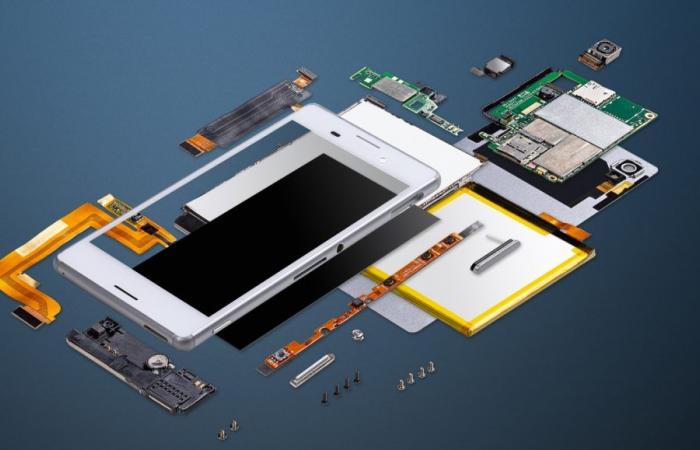A perfect symbol of the growing carbon footprint of digital technology, the smartphone is also a poorly understood object from an environmental point of view. Often intentionally designed as black boxes, our phones actually house tons of parts, themselves composed of tons of materials. Whether it’s the battery, the motherboard, the screen or the casing, each component has its own carbon footprint.
Let’s delve a little into the innards of these gadgets to see what it’s all about, piece by piece.
Introduction
Although precise costing, component by component, is a challenge due to the complexity of the production process and the opacity of most manufacturers on the subject, a few resources allow us to see more clearly.
We can notably cite the very comprehensive file that the Dutch manufacturer Fairphone published on the subject on the occasion of the release of its latest telephone, or a study from the University of Zurich published in 2020 and supervised by Lorenz Hilty, professor responsible for the research group on computer science and environmental sustainability.
For more information on the methodology used in this article, go to the box at the end of the page
1 – The motherboard
In first place on the podium for the most polluting components is the motherboard and its multiple printed circuits, chips and capacitors. According to figures revealed by Fairphone, this component alone would be responsible for 71% of the total carbon footprint of the production of a phone. Figures more or less confirmed by the study from the University of Zurich which differentiates the production of printed circuits and that of soldered chips.
For those who closely observe techno-ecological issues, no surprises here. The construction of a motherboard and its components involves around thirty metals, ores and rare earths that must be extracted, refined and mixed to develop the alloys necessary for their proper functioning. Overall, the higher the number of materials required for the functioning of a part, the higher its carbon footprint will be.
The list of materials present in a smartphone.
© Engineer without borders – CC BY-NC-SA 2.0
It is also interesting to note that the complexity of chips (allowed by ever more advanced engraving methods) increases their carbon footprint. On a daily basis The world In 2023, Lorenz Hilty explained that “When we studied manufacturers’ carbon footprints in 2020, the emissions calculations were based on older processors, which are much less transistor-dense than today’s. It is likely that the emissions associated with manufacturing the models we studied were underestimated.”.
2 – The screen
The only component truly visible to the consumer, the screen of a smartphone is the second most polluting element. Here, it is difficult to obtain a raw figure as the technologies and screen sizes differ on the market. Fairphone announces that its mobile display accounts for 5% of the total carbon footprint of construction, but on other phones this can rise to 10 or even 20%.
The larger the screen of a smartphone, the greater the quantity of materials required to manufacture it. In 2022, Frédéric Bordage, founder of the GreenIT collective, explained (here on TV) that “Producing a 45-inch LCD screen represents 175 kg of CO2 and 200 m² of water. Manufacturing a 53-inch Oled screen represents 800 kg of CO2 and 3540 m² of water”The same goes for smartphones, which integrate more than ten metals into the different layers of their screen.
Arcep has sounded the alarm on this subject. While the telecoms regulatory authority welcomes the fact that “the number of equipment placed on the market […] decreases”she warns that “This decrease could be offset by another trend: the share of larger screens (therefore the most polluting) [qui] increases for almost all types of terminals”The study by the University of Zurich shows this clearly, since tablets, despite their design similar to that of smartphones, have a much larger carbon footprint.
3 – The chassis
Surprisingly, after the motherboard and the screen, it is the chassis which closes the podium for the most polluting components. A sort of backbone of our smartphones, these parts very often contain numerous cables, connectors and components (the wireless charging coil, for example). Fairphone estimates that this part represents 9% of the carbon footprint of Fairphone 4 production.
Breaking down a smartphone’s carbon footprint, component by component.
© University of Zurich – CC BY-NC-ND 4.0
If the speaker, vibration motor or charging connector are integrated into the chassis, the ecological debt of this part obviously increases.
4 – The batteries
Finally, among the most important components, the battery accounts for about 5% of the carbon footprint in the construction of a smartphone. If this part has the luxury of not being so polluting, it is because the manufacturing process is well-established, with lithium batteries reigning supreme in the electronics industry for over a decade.
Eight metals are typically required to build a smartphone battery, including lithium, cobalt, phosphorus and aluminium. Here too, the exploitation of land and resources weighs heavily on the total carbon footprint of the component.
Not to mention that batteries wear out relatively quickly compared to other components of a smartphone, requiring to be changed more often than others. In absolute terms, the construction of a battery does not weigh too heavily on the carbon footprint of a smartphone, but it is a much more “consumable” component, so attention must be paid to it.
Conclusion
Smartphones are complex ecosystems where a whole bunch of metals, rare earths, gigahertz and pixels coexist. And while they allow us to access a bunch of virtual resources, the materiality of their ecological footprint must not be forgotten. Behind each small component is an entire industry that extracts, refines, builds… and pollutes, all in often catastrophic working conditions.
To ask manufacturers to do better, to know how to reduce your personal digital carbon footprint, or quite simply which spare parts are likely to cost the most ecologically speaking, it is therefore useful to memorize these orders of magnitude.






